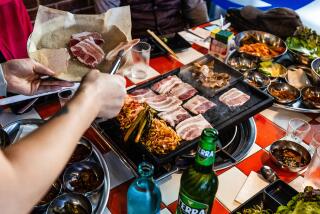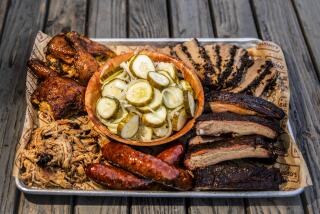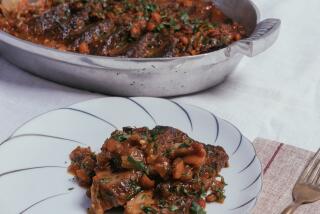‘Que and I
I have long considered beef brisket a succulent, versatile dish for fall. But it was not until a recent visit to Kansas City, Mo.--the heart of barbecue country--that I tasted barbecued brisket. It’s definitely delicious.
In Kansas City, there are many passionate arguments over what is the best barbecue; one’s taste is acquired over a period of time, sampling and tasting in the many wonderful barbecue spots around town.
There is even a basic disagreement over what actually constitutes “barbecue.” Rich Davis (originator of KC Masterpiece barbecue sauce) says that real barbecued meats are cooked slowly in a closed pit over indirect heat provided by hickory wood logs. But Ollie Gates barbecues his restaurants’ meats over direct fire mainly from hickory wood logs and a little oak thrown in--the drippings catch fire and provide a deep smokiness.
The Kansas City barbecue array includes ribs (baby back, country and beef), chicken, brisket, pork tenderloin and sausage. Burnt ends are considered a delicacy; they are the pieces of brisket that break off as the meat is sliced. The ends are piled between soft white bread--two or three slices (club sandwich-style)--and drenched with barbecue sauce (burnt ends are the specialty of Arthur Bryant’s famed barbecue stand). In Kansas City, barbecue sauce is always served on the side; it’s never slathered on while the meat cooks (as opposed to grilling). To flavor the meat while it cooks, a marinade or a mix of dry-rub seasonings is used.
On this trip, I found that brisket was great over indirect heat, cooked for a very long time, while ribs seemed to benefit from direct heat and quicker cooking. I preferred Rich Davis’ brisket and Ollie Gates’ ribs.
For home cooks, I was lucky enough to visit with Jimmy Kaplan, a hobbyist barbecue king, who showed me how smoking a brisket is easily done in the backyard. Use charcoal briquettes with hickory wood chunks in a smoker or pit barbecue. Arrange them in a circle with a pan of water set in the center. Keep the heat at a medium intensity and plan to smoke a 3 1/2-pound first cut of brisket for at least four hours, maybe six, until the meat is fork-tender. It’s important to trim the fat after the brisket is cooked, not before; the fat acts as a lubricant as the meat cooks. If briskets are delivered trimmed to your meat market, ask for some slices of beef fat to cushion the meat.
For those who don’t own a smoker or pit barbecue, I’ve included a slow-oven method; it takes no attention during the same hours of cooking, whereas the smoked brisket requires occasional refueling and adding water to the pan.
What makes a perfect menu with barbecued brisket? A noodle casserole, an old family recipe from Nebraska, and honey-mustard green beans make good fall eating with brisket. Coleslaw can be added, and be sure to serve chilled beer or fresh lemonade with the meal. And don’t forget the barbecue sauce . . . served on the side!
Beef brisket Kansas City-style is slow cooked, centered on a rack over a pan of hot water in a smoker or pit barbecue. The indirect, medium-intensity heat is generated by two layers of charcoal briquettes and a few hickory wood chunks that have been soaked in water. Depending on the brisket itself, the cooking may take four to six hours. An instant reading thermometer should read about 160-degrees and the meat should be fork-tender. It’s best to cook the meat well ahead of time so it can be trimmed of all visible fat before serving it. Remember, it’s important to leave the fat on the meat as it cooks. The barbecue sauce is the key; boost a commercial variety with cumin, garlic, sauteed onion, brown sugar or honey and cayenne pepper until you have the best flavor. For an oven version, see the variation to the recipe.
BARBECUED BRISKET KANSAS CITY-STYLE
1 teaspoon Hungarian paprika
1 teaspoon ground cumin
1/2 teaspoon salt
1/2 teaspoon black pepper
1 1/2 teaspoons sugar
Generous dash cayenne pepper
1 (3 1/2-pound) beef brisket, first cut
Bottled barbecue sauce
Combine paprika, cumin, salt, pepper, sugar and cayenne in small dish. Rub seasonings into meaty surface of brisket. Do not bother to season fat.
Place brisket in prepared smoker or covered charcoal barbecue as described above. Cook, covered, until meat registers about 160 degrees on instant reading thermometer and is fork-tender, about 4 to 6 hours, depending on quality of meat. Fuel fire and refill water pan as necessary.
Remove and discard any loose slices of fat. Wrap brisket in foil. Let stand at room temperature until cool enough to trim away all visible fat. Or alternately, refrigerate overnight for fat to congeal which makes trimming easier.
To serve, meat should be hot or at room temperature. To reheat, brush on little barbecue sauce to keep meat moist, then tent meat airtight in foil and cook in 300-degree oven until heated through, about 30 minutes. Use electric knife to slice very thin. Serve with barbecue sauce on side. Makes 6 servings.
Variation:
To cook in oven, extra slices of fat are not required. Season meat as above. Place on large piece of heavy duty foil and tent, airtight, so foil does not touch meat. Place foil package on jelly roll pan. Bake at 300 degrees 3 1/2 hours. Open foil and bake until browned, thermometer registers 160 degrees and meat is fork-tender. Remove from oven. Close foil package and let stand until cool enough to trim away all visible fat.
A slightly sweet, old-fashioned noodle pudding with apples and raisins makes an ideal homey accompaniment to the barbecued brisket or any roasted beef or poultry. This recipe dates from the turn-of-the-century and was included in a personal collection of Nebraska recipes.
GRANDMOTHER’S NOODLE PUDDING
2 tablespoons unsalted butter
4 large eggs, separated
2/3 cup plus 2 tablespoons sugar
1/8 teaspoon salt
1/2 cup milk
12 ounces egg noodles, cooked according to package directions, rinsed and well-drained
1/2 cup raisins
3 large (1 1/2 pounds) Granny Smith apples, peeled and thinly sliced (best done in food processor with thin slicing disc)
1/2 cup sliced almonds with skins
1/4 teaspoon ground cinnamon
Combine butter, egg yolks, 2/3 cup sugar and salt in mixing bowl. Beat in mixer until light and fluffy, about 3 minutes. Add milk. Mix until combined. Stir in cooked noodles and raisins. Whip egg whites until they hold shape but are still moist. Fold whites into noodle mixture.
Arrange half apple slices over bottom of greased 6-cup capacity shallow baking dish or 9-inch square baking pan. Spread half noodle mixture over apples. Repeat layering and spread noodles evenly.
Place on center rack of oven and bake at 350 degrees 40 minutes. Sprinkle casserole with sliced almonds. Combine remaining 2 tablespoons sugar and cinnamon and sprinkle on casserole. Bake until almonds are golden brown and pudding is set, about 20 minutes more. Serve hot. Can be made day ahead and refrigerated. Reheat, covered with foil, in 300-degree oven until heated through, about 30 minutes. Makes 6 servings.
Tender greens beans are available in early fall; they’re great quickly blanched, then tossed in a mixture of mustard and honey just before serving.
HONEY-MUSTARD GREEN BEANS
2 pounds slender green beans, stem end trimmed
1 tablespoon plus 1 teaspoon honey
1/3 cup chicken broth
1 tablespoon Dusseldorf-style mustard
1 tablespoon unsalted butter
Salt
Freshly ground pepper
3 green onions, thinly sliced
Add green beans to 3-quart pot with boiling salted water to cover. Simmer, uncovered, until just tender, about 4 minutes. Drain and immediately place in ice-cold water until beans are cold. Drain well. Can be cooked several hours ahead and kept at room temperature.
Bring honey, chicken broth and mustard to boil in 10-inch non-stick skillet over medium-high heat. Stir in butter until melted. Add green beans. Toss well to combine. Cook to heat through, about 4 minutes, tossing frequently to distribute heat and avoid burning. Season to taste with salt and pepper. Mix well. Remove from heat. Add green onions. Toss to combine. Serve immediately. Makes 6 servings.
More to Read
Eat your way across L.A.
Get our weekly Tasting Notes newsletter for reviews, news and more.
You may occasionally receive promotional content from the Los Angeles Times.







